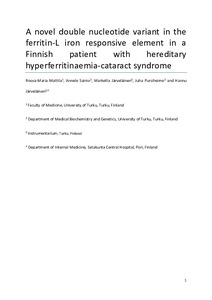A novel double nucleotide variant in the ferritin-L iron-responsive element in a Finnish patient with hereditary hyperferritinaemia-cataract syndrome
Roosa-Maria Mattila; Juha Pursiheimo; Annele Sainio; Hannu Järveläinen; Marketta Järveläinen
https://urn.fi/URN:NBN:fi-fe2021042716877
Tiivistelmä
ABSTRACT.
Purpose: To present a novel Finnish double nucleotide variant in the ironresponsive
element (IRE) of the ferritin L-chain gene (FTL) leading to
hyperferritinaemia-cataract syndrome (HHCS).
Purpose
To present a novel Finnish double nucleotide variant in the iron-responsive element (IRE) of the ferritin L-chain gene (FTL) leading to hyperferritinaemia-cataract syndrome (HHCS).
Methods
Genomic DNA extracted from peripheral blood leucocytes and synthetized with three different primers flanking the IRE in the FTL 5′-untranslated region of the FTL was used in polymerase chain reaction (PCR). Thereafter, Sanger sequencing was performed on the 487-bp and 602-bp PCR amplification products with specific primers to reveal FTL IRE mutations.
Results
A 58-year-old female patient with elevated serum ferritin level (1339 μg/l) was diagnosed with HHCS after extensive workup. Genetic testing identified a novel double point mutation g.48965355G>C (chr19, hg19) and g.48965356G>T (chr19, hg19) in the lower stem region of the IRE canonical structure of the FTL.
Conclusion
After excluding other causes, elevated serum ferritin level in a person with early onset cataract is indicative for HHCS, a genetic disorder caused by mutation in the IRE of the FTL.
Kokoelmat
- Rinnakkaistallenteet [19207]
